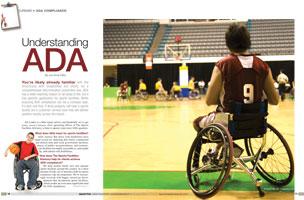
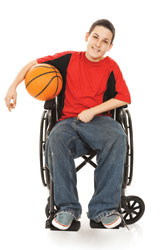 You're likely already familiar with the Americans with Disabilities Act (ADA). As a comprehensive discrimination prevention law, ADA has a wide-reaching impact on all areas of life, but it has specific application for sports facilities. While ensuring ADA compliance can be a complex task, it's also one that, if done properly, will help a sports facility set a customer service tone that will deliver positive results across the board. All it takes is a little expert advice, and thankfully we've got some. Jason Clement, chief operating officer of The Sports Facilities Advisory, is here to answer your every ADA question.
You're likely already familiar with the Americans with Disabilities Act (ADA). As a comprehensive discrimination prevention law, ADA has a wide-reaching impact on all areas of life, but it has specific application for sports facilities. While ensuring ADA compliance can be a complex task, it's also one that, if done properly, will help a sports facility set a customer service tone that will deliver positive results across the board. All it takes is a little expert advice, and thankfully we've got some. Jason Clement, chief operating officer of The Sports Facilities Advisory, is here to answer your every ADA question.
What does ADA mean for sports facilities?
ADA ensures that those with disabilities have equal access by requiring that newly constructed and altered state and local government facilities, places of public accommodation, and commercial facilities be readily accessible to, and usable by, individuals with disabilities.
How does The Sports Facilities Advisory help its clients achieve ADA compliance?
We help people build, own and operate sports facilities around the country. In a short amount of time, we've become a hub for sports complexes and developments. We're increasingly involved with bigger, mixed-use developments that incorporate sports facilities, which creates an even more significant need for ADA compliance.
Our perspective is that it's crucial for all sports complexes to be ADA compliant in one way or another. Those with disabilities or special needs should have access to the same activities and facilities as the rest of us. And so we work with clients-and their architects, engineers, etc.-to make sure all their ADA compliance issues are covered.
Is it more expensive to build an ADA complaint building? How can a facility planner mitigate those costs?
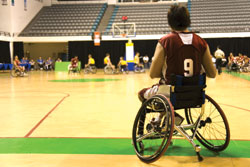 |
| © Shariff Che'Lah - Dreamstime.com |
When you're building a brand new facility, you have build ADA complaint. It does add cost, for example putting in elevator when you could have a stair, but by code it has to happen. However, there are ways to design a facility in more efficient manner so that it is both ADA compliant and more economical at the same time, and an experienced architect and/or consultant can help facility owners achieve that balance.
ADA Compliance seems overwhelming. How can I approach ADA compliance in a manageable way?
We have a few general rules of thumb for new facilities. In the preliminary design and concepting phase, we try to help our clients and their entire team think from the perspective of their users, both with and without disabilities. As a business, you want to exceed the expectations of all your clients, which includes people with disabilities, and since such a wide range of disabilities exists, planning your facility to meet those needs requires a lot of forethought. The goal is to ensure that your disabled clients have not just access, but the same kind of access, to all of your facility's programs and spaces as every other customer. For example, if you're building a fitness center, and you have a certain type of equipment, like an elliptical machine, up on a mezzanine, you need to have same equipment on a ground floor, or the building should have an elevator to that mezzanine.
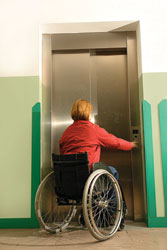 From a spectator standpoint, we want to be sure anyone with a disability has access to same type of seats and/or pricing that someone without disabilities would have. Think about seating in an arena: for floor seating, which is highly desirable, we want to make sure there's accessible space identified for someone with disabilities there. But also a few rows up, if there's a price change, we need to make sure the accessibility is there too. It's the same with club seating, suites, upper deck-type seating, everywhere.
From a spectator standpoint, we want to be sure anyone with a disability has access to same type of seats and/or pricing that someone without disabilities would have. Think about seating in an arena: for floor seating, which is highly desirable, we want to make sure there's accessible space identified for someone with disabilities there. But also a few rows up, if there's a price change, we need to make sure the accessibility is there too. It's the same with club seating, suites, upper deck-type seating, everywhere.
Another consideration is mobility within the facility. There is often limited space in corridors, circulation pathways, restrooms, so we need to make sure there is at least one space within each of those areas that is accessible for someone with a disability.
The way we do this-and to make sure that no areas are missed-is to visualize the experience of the individual as he or she engages within the sports complex. You have to be sure to consider both spectators and participants. Start in the parking lot: as you approach the complex, through gates or the front door, how are you greeted? What do you see, smell, hear, and how will you proceed to where ever you're going, where you'll be watching or playing or practicing?
We always go through that progression with our clients to make the experience their facility offers to all visitors the best we can. We do it from the perspective of clients with and without disabilities. That way, if something's overlooked, we can adjust the plans.
Older or historical structures have different requirements, often being grandfathered in, where ADA compliance is concerned. We advise clients who purchase or own historical structures to make physical changes as long as it's financial feasible to do so, but for some of these buildings it's just not possible to bring everything up to code without destroying the building or the business.
Wrigley field s a great example. I was just there the other day, and I noticed what a good job they're doing. There was someone in a wheelchair in front of me, a man who'd broken his leg. Now, Wrigley Field is nearly a century old, so its structure contains none of the accessibility considerations we're accustomed to in modern buildings, but the owners of Wrigley Field have made as many structural adaptations as possible. In order to accommodate wheelchairs, for example, they poured concrete ramps over existing stairs.
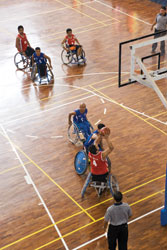 But they've gone even further than that, using customer service to ensure that disabled patrons have the best experience possible. Two customer service representative accompanied the man who sat in front of me,making sure that he was able to get to his seat easily and comfortably in his wheelchair. It just showed that there's a lot you more you can do than just make structural changes to make people feel comfortable and well served.
But they've gone even further than that, using customer service to ensure that disabled patrons have the best experience possible. Two customer service representative accompanied the man who sat in front of me,making sure that he was able to get to his seat easily and comfortably in his wheelchair. It just showed that there's a lot you more you can do than just make structural changes to make people feel comfortable and well served.
Are there innovative building techniques or technologies out there that are helping make ADA compliance easier?
Absolutely. Take stairs for example. The easiest and most cost effective way to deal with level changes in your facility are good old-fashioned ramps. But there are some new chair rail lifts that can convey disabled patrons three or six feet, not even a full story, that can easily ensure complete, comfortable access for all visitors.
Who is responsible for making sure that a sports facility is ADA compliant?
Of course, the final legal responsibility falls to the facility owner, which is why it's critical that you have an understanding of ADA compliance requirements as well as experienced team.
In terms of the team, for most projects, ADA compliance is ultimately the architect's responsibility. Owners also have the option to hire a code specialist, and there are some really good ones out there, but that's typically done for larger stadiums and arenas.
There's another level of supervision you can employ, such as hiring an advisory team like our firm. Most of the time we are hired to be an agent for our clients, the facility owners, to act as a liaison between the clients and their architects and builders. We help up front with business modeling, feasibility studies, fundraising and so one. In addition to that, we help oversee that the design and construction team meets all its goals, including achieving ADA compliance, and that they do it on time and under budget.
According to the most recent census, more than 51.2 million, or nearly one in five, Americans are disabled. Learn more about how you can best serve your disabled patrons and maintain your facility's ADA compliance at www.Ada.gov.

